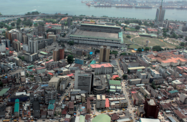Lower hydrocarbons revenues, tight capital controls and currency volatility combined to make 2016 a challenging year for Nigeria.

By December the country was in recession, facing its first full-year contraction for almost three decades, with the IMF expecting Nigeria’s economy to shrink by 1.7%.
Inflation, meanwhile, had climbed to an 11-year high by October. However, the outlook for 2017 appears brighter for what is still Africa’s largest economy by GDP.
Reforms, combined with a new budget, an anticipated rise in oil prices and international funding should see Nigeria return to growth in 2017, according to forecasts.
Economic pressures
With oil prices plummeting to an average of around $45 per barrel, down from highs of $115 in 2014, Nigeria faced a significant drop in revenue in 2016.
A spate of militant attacks on gas pipelines over the summer added to the economic pressures, pushing exports down to their lowest levels in nine years and reducing Nigeria’s power output in May to around 1 GW from an installed capacity of 12 GW.
In a key move the government took the decision in June to de-peg the naira from the dollar and introduce a managed float to allow for a more flexible exchange market.
The decision was, in part, a response to a widening gap between the official exchange rate and the parallel market. Authorities also faced dwindling reserves in 2016, having spent much of the first half of the year trying to shore up the pegged naira. The Central Bank of Nigeria spent approximately $4.7bn in the first quarter in its efforts to support the local currency, with reserves having slipped to $25.8bn by mid-August.
Investors welcomed the float, which came after several months of capital controls that hampered access to imports, with the Nigerian Stock Exchange (NSE) gaining 5.8% in the two-day period following the announcement. However, the de-pegging also contributed to higher prices, with inflation rising from 16.5% in June to 18.48% by November.
Positive developments
The year also brought several positive developments for the country, including the launch of a multi-pronged drive to attract funds for several projects across various sectors of the economy.
In October the government said it was targeting $5bn in investment for Nigeria’s mining industry as part of a bid to boost the sector’s contribution to GDP from less than 1% to 7% over the next decade.
Long a topic of discussion, energy reforms could also be set to materialise in 2016. In November drafts of the National Oil Policy and the National Policy on Gas were approved by the Cabinet and submitted to Congress, signalling progress in the country’s Petroleum Industry Bill.
There were also signs that change was afoot at state-owned Nigerian National Petroleum Corporation (NNPC), with the implementation of a restructuring programme and the replacement of several executives.
Early in 2016 the company bowed to pressure to improve transparency by releasing its financial results for the first time in 10 years. The government has said it would like to see NNPC listed on the NSE in 2017.
Return to growth expected
A combination of loans and potentially higher global oil prices look set to lead Nigeria back to growth in 2017.
In November, the African Development Bank agreed to lend the government $600m to offset its $7bn deficit, with a further loan of $400m to be made available in 2017 subject to Nigeria meeting several conditions. Talks are also being held with the World Bank on additional financing.
The planned launch of Nigeria’s first international bond since 2013 should also provide the economy with a boost. Standard Chartered, Citi and Nigeria’s Stanbic IBTC are all in talks with the authorities with a view to underwriting the bond, which is scheduled to take place in the first quarter of 2017.
Higher oil prices, meanwhile, are expected to provide the biggest boost to growth. Prices have already risen by around 14%, following the decision taken in November by members of the Organisation of the Petroleum Exporting Countries, with the exception of Nigeria and Libya, to cut production to 1.2m barrels per day in January. Analysts expect prices to reach between $50 and $60 per barrel in 2017.
Looking ahead, the IMF has forecast GDP growth of 0.6% for Nigeria in 2017, an improvement on the last year’s recession. Ratings agencies are more optimistic, with Moody’s and Fitch projecting increases of 2.5% and 2.6%, respectively.


